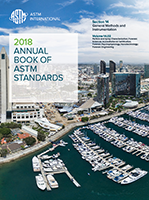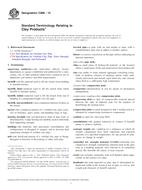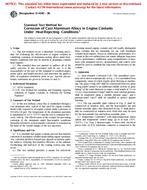1.1 This practice covers information that will permit design of a rational cleaning procedure that can be used with a glass that is somewhat soluble in many aqueous chemical solutions. Typically, this type of glass is used in applications such as optical ware, glass-to-metal seals, low dielectric loss products, glass fibers, infrared transmitting products, and products resistant to metallic vapors.
1.2 In most cases, this type of glass contains high concentrations of oxides that tend to react with a number of aqueous chemicals. Such oxides include B2O3, Al2O3, R2O, RO, La2O3, ZnO, PbO, P2O5, and Fe2O3. The more conventional high-silica glasses are usually more chemically resistant, but the cleaning principles outlined here also apply to them.
1.3 This standard does not purport to address all of the safety concerns, if any, associated with its use. It is the responsibility of the user of this standard to establish appropriate safety and health practices and determine the applicability of regulatory limitations prior to use. Specific hazard statements are given in Section 4 and Table 1.
TABLE 1 Relative Solubility of Various Glass Component Oxides in HF, Other Inorganic Acids, and NaOH, in Concentrated Solutions at Room Temperature
Note 1 – Macro or minor/trace levels will determine degree of precipitation, especially in acids, for example, HNO3 (Sn, Sb, Mo).
Note 2 – W is soluble in acid but heat may precipitate it, for example, H2WO4.
Note 3 – Sn+4 is soluble in hot H2SO4; Sn+2 is soluble in other reagents as well.
Note 4 – Most alkali solutions must be hot to effect solution.
Note 5 – PbSO4 is soluble in hot concentrated H2SO4.
Note 6 – Sb and Bi form insoluble oxychlorides in dilute HCl.
Note 7 – Ba is insoluble in concentrated HNO3.
| Oxides of | HF 49 % |
H2SO4 96 % |
HNO3 70 % |
HCl 37 % |
HBr | HI | H3PO4 85 % |
NaOH 50 % |
|---|---|---|---|---|---|---|---|---|
| Al | sA | s | s | s | i | i | i | s |
| Sb | iA | i | i | s | s | s | i | s |
| As | s | s | s | s | s | s | s | s |
| Ba | i | i | s | s | s | s | s | s |
| Be | s | s | s | s | s | s | s | i |
| Bi | s | s | s | s | s | s | s | i |
| B | s | s | s | s | s | s | s | s |
| Cd | s | s | s | s | s | s | s | s |
| Ca | i | s | s | s | s | s | s | s |
| Ce | i | s | i | i | i | i | i | i |
| Cr | i | i | i | i | i | i | i | i |
| Co | s | s | s | s | s | s | s | i |
| Cu | s | s | s | s | s | s | s | i |
| Er | i | s | s | s | s | s | s | i |
| Eu | i | s | s | s | s | s | s | i |
| Gd | i | s | s | s | s | s | s | i |
| Ga | s | s | s | s | s | s | s | i |
| Ge | s | s | s | s | s | s | s | s |
| Au | i | i | i | i | i | i | i | i |
| Hf | s | i | i | i | i | i | i | i |
| Fe | s | s | s | s | s | s | s | i |
| La | i | s | s | s | s | s | s | i |
| Pb | i | i | s | i | i | i | s | s |
| Li | s | s | s | s | s | s | s | s |
| Mg | i | s | s | s | s | s | s | i |
| Mn | s | s | s | s | s | s | s | i |
| Mo | s | s | iB | s | s | s | s | s |
| Nd | i | s | s | s | s | s | s | i |
| Ni | s | s | s | s | s | s | s | i |
| Nb | s | i | i | i | i | i | i | i |
| Pd | s | s | i | i | i | i | i | i |
| P | s | s | s | s | s | s | s | s |
| Pt | i | i | i | i | i | i | i | i |
| K | s | s | s | s | s | s | s | s |
| Pr | i | s | s | s | s | s | s | i |
| Pm | i | s | s | s | s | s | s | i |
| Rh | i | s | s | s | s | s | s | i |
| Rb | i | s | s | s | s | s | s | i |
| Ru | i | s | s | s | s | s | s | i |
| Sm | i | s | s | s | s | s | s | i |
| Se | s | s | s | s | s | s | s | s |
| Si | s | i | i | i | i | i | i | s |
| Ag | s | s | s | i | i | i | s | i |
| Na | s | s | s | s | s | s | s | s |
| Sr | i | i | i | i | i | i | i | i |
| Ta | s | i | i | i | i | i | i | i |
| Te | s | s | s | s | s | s | s | s |
| Tl | s | s | s | s | i | i | s | i |
| Th | s | sB | i | i | i | i | i | i |
| Sn | s | s | s | s | s | s | s | s |
| Ti | s | sB | i | s | i | i | i | i |
| W | s | i | i | i | i | i | i | s |
| U | s | s | s | i | i | i | i | i |
| V | s | s | s | s | s | s | s | s |
| Yb | i | s | s | s | s | s | s | i |
| Y | i | s | s | s | s | s | s | i |
| Zn | s | s | s | s | s | s | s | s |
| Zr | s | sB | i | i | i | i | i | i |
A s = relatively soluble, i = relatively insoluble.
B hot
Product Details
- Published:
- 09/01/2008
- Number of Pages:
- 6
- File Size:
- 1 file , 100 KB


